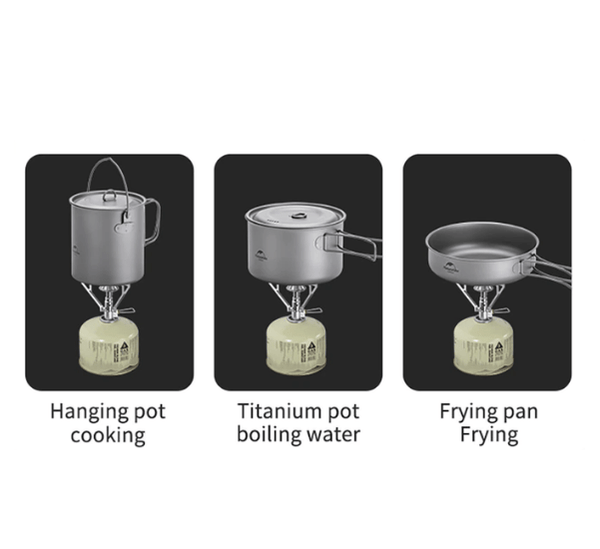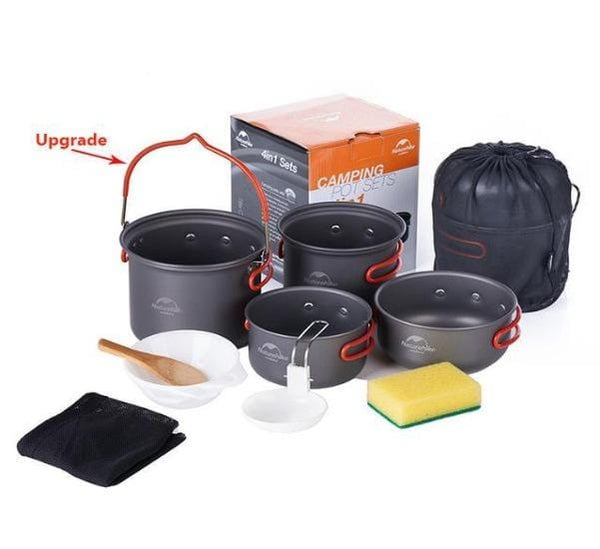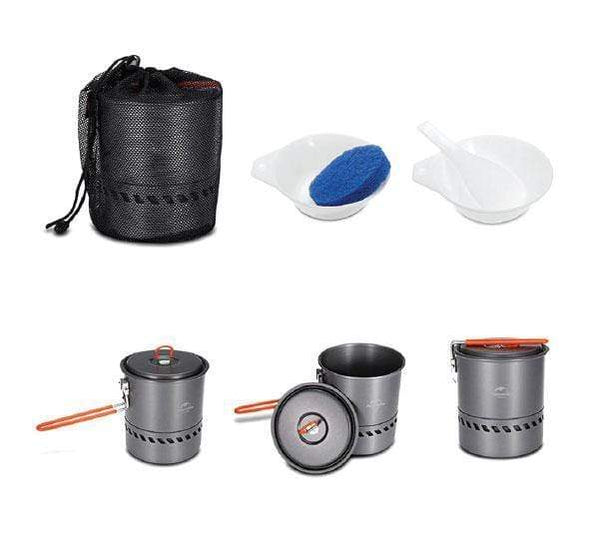- No products in the cart.

As a kid, if there is one thing we always look out for when going on a camping trip is nothing but sitting around a bonfire at night, sharing spooky stories with our pals while roasting marshmallows. Classic good old days, right? Now that we are adults, we are assigned to plan and cook meals during camping — which is not as easy as roasting marshmallows.
Cooking inside your home is already challenging; what more if it is done outside, far from all your magical kitchen cookware? So what are we going to do? Are we going to eat marshmallows now and then? Although we can do that, are you sure you want that?
Before you start biting your nails out of worry, we are here to rescue your day and help you plan your upcoming trip. From preparation to finding the right camping cookware and more, we are here to help you become the master chef of the forest.
What Camping Cookware Do You Need?
Pots and pans at home should be left at home. Instead, figure out the camping cookware you will need during your stay. This cookware is designed to ease al fresco cooking by being lightweight, compact, and versatile. They may be smaller than your casserole at home, but they are precisely the ones you should tag along with during your trip.
Cooking Pots
Go for the collapsible sets when looking for cooking pots for your outing. These pots are almost the size of one cooking pot but come with other types of cooking pots, such as a three-pcs camping cookware set. They come in handy, and although they are adorable and miniature, they can fill the hungry stomachs of up to two to three campers. Select pots made from lightweight aluminium alloy with non-stick Teflon coating to keep your life easier, and these camping cooking pots tend to last longer and are easier to use when cooking.
Camping Stoves
There are many ways to get a fire when camping, but the most common practice is to bring a portable gas stove. Modern camping cookware has already evolved so does the furnace. Foldable camping stoves are now the most in-demand hiking gear these days. They are lightweight and compact while providing efficient heat for cooking. Check if the stove has an ignition system so you can bring it during stormy or snowy weather because it does not require matches.
Foldable Utensils
Likewise, search for foldable spoons and spatulas to help you when cooking. Apart from flexibility and being easy to bring, they are also space savers compared to regular utensils such as wooden spoons. If you worry that they are fragile and will turn limp, pick those made from titanium alloy since they are sturdier and highly suitable when cooking with high heat.
Windshield
Technically speaking, a windshield is not cookware, but you still need to bring one when cooking. For example, suppose you are cooking at an open campsite. In that case, a windshield will give you unprecedented benefits from keeping the balance of the fire and allowing you to cook your meals properly since it shields the air from bugging your camping stove. Modern windshields are now outlined to be foldable and made from stainless steel or aluminium.
Reusable Dinnerware
Instead of paper plates and cups, choose reusable dinnerware made from stainless steel, aluminium, and titanium. Aside from keeping the 'leave no trace' mantra alive, these are good heat conductors and will save you money in the long run.
Tips When Picking Out Cookware Materials
Now that we know what cook sets to carry, we must also consider the materials used in making these sets. Knowing the material means knowing how you can take advantage of it:
Aluminium
If you did not skip your science class, we would all agree that aluminium is an excellent conductor of heat, ideal for simmering foods. This material is also lightweight and affordable, so most are fond of it. But unfortunately, it tends to warm in high heat and breaks down quickly when exposed to acidic foods.
Stainless Steel
Compared with aluminium, stainless steel is more rigid and resistant to scratch, rust, and corrosion. In addition, it is non-reactive to certain foods and is not high maintenance. However, it is heavier and does not conduct a uniform heat.
Non-stick Coatings
Getting cookware with non-stick coating makes cleaning a breeze while saving time and energy. It is highly recommended when cooking fried eggs and other camping food essentials that tend to stick on surfaces. Although this material is reliable, it is less durable if we will compare it to regular metal surfaces and prone to scratches.
Titanium
Titanium is the safest option when choosing between lightweight and strength since it dabbles in both. It heats up fast and is also highly resistant to corrosion. Another good thing about titanium is its ability to operate effectively under any heat and cools down quickly. It is indeed a promising material to use for cookware, but it is more on the expensive side, not ideal for those who are on a tight budget.
Cast Iron
A cast iron pot is an excellent choice for long and low simmering. Unlike titanium, cast iron is affordable and provides heat evenly. If accurately seasoned, it can also act as a non-stick. Unfortunately, due to its weight, it is not advisable for backpacking and is reactive to acidic foods.
Plastic
Most backpackers enjoy using plastics since they are widely available and relatively cheap. But this material is not durable, not heat-resistant, and can even retain the flavours and odours of the food. On top of that, mother nature is not a fan of plastic.
How To Give Your Camping Cookware A Little TLC?
If you want your camping cookware to last, make sure that you give them a little tender loving care (TLC) whenever you are using them. The more you care for your belongings, the longer they last. That being said, here are some tips on how to care for camping cookware.
Bring Buckets
Not necessarily the big ones, but rather tag-along collapsible buckets for cleaning or fetching water. Having a bucket that you can fold saves space and can act as an aid when cleaning, especially when you cook a hearty beef stew that is most likely sticky with leftover beef tallow that requires much water to remove. But, of course, that is also wise if your tent is far from nearby water resources.
Purified Water
We may love dipping in a cold river with crystal clear water when camping, but remember that it can also carry harmful bacteria and protozoa that can affect our bodies when ingested. Therefore, when cleaning, it is best to purify the water first before using it (we are just making sure here. Let us be vigilant and remember that it is always better to be safe than sorry). If you forgot to bring a purification tablet or UV sterilization gear, you could boil water on your stove to sterilize your cookware after washing them.
Avoid Using Abrasive Cleaners
Opt for biodegradable soap and water when cleaning. Using abrasive cleaners and items such as scouring pads can ruin the coating of your camping cookware and can alter its performance. For Teflon-coated cookware, avoid cutting food with a knife in a Teflon pot apart from steering clear of abrasive cleaners and tools. We also suggest cleaning the pan immediately after cooking to circumvent hard-to-clean residues. Going for a biodegradable soap will not leave a mark on the local ecosystem and can equally give your tools a thorough cleaning.
Do Not Leave Your Cookware Dirty
Leaving your cookware dirty is unhygienic and can attract critters to your base camp. Think of a raccoon or a fox devouring meals from your cookware. Instead, empty your camping cookware and clean them right after using them. If you have leftover food you do not want to eat anymore, dispose of it properly in a trash bag away from your base camp. As for the water used in cleaning, throw it at least 200 feet away from a water source with plenty of sunlight so it can evaporate quickly.
Dry Before Storing
Warping and cracking can happen when you use a pan after washing it with water. If you dry your cookware and utensils at home before storing them, the same goes for your camping cookware. That will even prevent moisture from getting into your storage boxes. Make it a habit to pat them with a dry soft towel after washing them.
How To Clean Camping Cookware Without Water?
What if you are a first-time camper, all giddy and excited about your upcoming trip with little to no idea where you will be camping? Then, along your expedition, you realize the nearest water resource is far from your camping site. Still, quitting is too late because you have already settled down with warm chicken tzatziki skewers with your one-pot pasta primavera, so how will you clean your cookware?
That may sound wild, but we can use dirt to clean off dirt. Seasoned campers in the same situation know that using a speck of dry dirt can scrape grease, oil, and leftover residues in a pot. All you need to do is fill your cookware with soil and smear the ground around the sides using a spoon or a knife. Do this a few times until you see your pan getting clean. Lastly, get your collapsible bucket or water bottle and rinse the dirt. This method will not damage your cookware, but if you are keen on cleanliness, wash your items when you get home or find a place with clean water.
Extra Tips and Tricks
Let us ace your camping cookware guide with more tips and tricks:
Plan Your Pots
Always pack light, including for your pots. Before going on a trip, plan the foods you cook to know the number of cooking pots you need.
Always Bring Lids
Great way to save fuel when cooking is by covering the pot with lids. Go for cookware with a cover to reduce cooking time, save gas, and avoid splatter.
Handy Utensils
Instead of a spoon and fork, pick a spork instead. It is a backpack essential that can fit anywhere. Also, remember to add other cooking tools to your checklist, such as whisks, measuring spoons, and spatulas for cooking.
Bring Aluminium Foil
On every camping trip, aluminium is always a must-have camping essential. You can use it for cooking over an open fire or serve it as a cover for your food to avoid dirt and bugs from infiltrating. In addition, using foil to cover your meals keep your food warm for an extended period.
Conclusion
Cooking outside of your home is a new experience everyone should try every once in a while. Although it can be a heck of a job, knowing the right camping cookware can make you a master chef of the forest in no time. Remember that you must ensure your cookware embodies ultralight backpacking to ensure you will not spend hours complaining about your heavy equipment and instead experience unmatched comfort and relaxation.
If you plan on camping more often, invest in cookware worth your money. Look for those built from sturdy materials so they can last for years. But even high-quality cooking sets can get damaged easily without proper maintenance. Therefore, before placing your orders, check out the cookware material to know how to clean them properly. Given all the tips and tricks we have listed in this article, we are confident that you can ace your cooking skill in the forest and delight your taste buds with not just burnt mallows.
Remember to share your first camping cooking experience with us in the comment section below. And be sure to check out our other camping guides to help make your trip extra fun and exciting.















